8K Ultra HD TVs

Shop by screen size
Get watching with these great TV deals
*Offer excludes Best Buy Marketplace products.

51 results
The big picture of 8K TV
Television technology has once again made the move to a newer, better and more eye-popping format. 8K resolution has finally arrived commercially, and these new ultra-high resolution models are going to fast become the most desired TVs on the market. But, what is 8K and how much better is it? Here’s a rundown on what you need to know.
What does 8K mean?
The basic “HDTV” televisions we are familiar with have a resolution of 1080p. That means the television has 1,080 pixels across the set vertically, and 1,920 pixels horizontally. Next (and quite recently) 4K televisions hit the market, offering 3,840 by 2,160 pixels. It is called 4K, as the term originated with digital cinema, which measures pixels on the horizontal plane. However, as 4K TV offers double the horizontal and vertical resolutions of 1080p HDTV, it is colloquially called “4K” (and also ultra HD or UHD) by everyone, although the true technical term is Ultra HD. Now 8K TV has entered the commercial market, bringing twice the resolution of 4K with an incredible 7,680 x 4,320 pixels. That gives 8K television sets twice the horizontal and vertical pixels of 4K models, and an almost impossible sounding 16 times more pixels than traditional HDTV at 1080p.
Who is selling 8K TVs?
The first commercial 8K TV to hit the US market was an 85-inch from Samsung in fall 2018. However, as of 2019 big television brands, such as Sony, LG and TCL are all beginning to manufacture this new Ultra HD standard. For example, Sony BRAVIA XR TVs allow you to experience the dramatic beauty of 8K picture quality and explore the world like never before, powered by Sony's all-new Cognitive Processor XR. But, as with when 4K televisions made their debut, other companies will begin to come out with their own 8K TVs once the format becomes the default or standard resolution.
Will I need new cables or devices with 8K?
The new HDMI 2.1 standard supports 8K resolution at up to 60 fps, and it requires almost triple the bandwidth of 4K-capable HDMI 2.0. What this means is that your current Blu-ray players, game consoles and streaming devices will max out at 4K. You'll need new HDMI 2.1-equipped devices that can process 8K video and output it to an 8K TV. However, before you rush out and stock up on HDMI 2.1-compatible cables, keep in mind there will almost certainly be a new standard between now and wide adoption of 8K. So those cables might be obsolete, despite their current forward-looking appearance.
What can I watch on an 8K television?
Right now, you won’t find a lot of 8K content for home viewing. Much like when 4K sets made their debut, it takes a while (often years) for Hollywood, streaming services and networks to get up to speed in terms of the higher resolution. For any new format to be viewable in your home you need three things: content, transmission and playback. The new 8K televisions are what will be taking care of the playback side of things. However, when it comes to content, that is where things get a bit more difficult.
You will be able to find some lower resolution content that has been upscaled to 8K, but right now there is a severe lack of content available. At least one network in Japan has begun experimenting with 8K broadcasts, but the studios and streaming services have said very little about 8K distribution so far in North America.
How much is an 8k TV?
The new television format is quite expensive. Right now you will be paying on average $10,000 or above for an 85-inch model. So, 8K TVs will likely remain out of reach for most consumers this year, but you can expect prices to start falling quickly now that major manufacturers are producing them. In the same way that 4K prices dropped dramatically over just a couple of years, 8K pricing will follow suit — and likely even faster.



